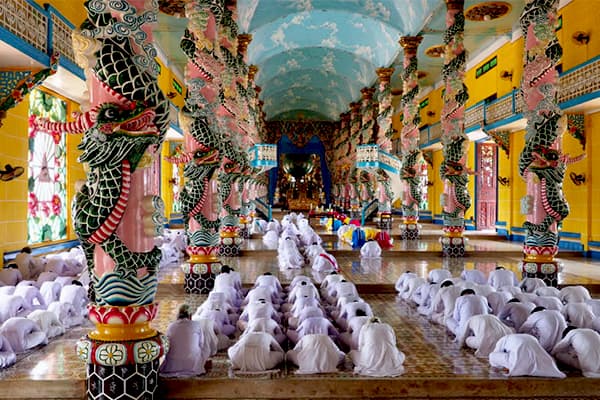CAO DAI TEMPLE - SOUTHERN VIETNAM
CULTURAL JOURNEY TO THE MAGNIFICENT TEMPLE
The Cao Dai Temple (also known as Cao Dai Holy See) was built in 1933 in a unique architectural style that reflects its mixed traditions. Of all the places for a day trip from Ho Chi Minh City, in Southern Vietnam, a visit to the Cao Dai Temple is one of the best things to do to fully enjoy the unique local atmosphere.
Cao Dai Religion in Vietnam
The Cao Dai (Caodaism) religion was founded in 1926 in Southern Vietnam. Cao Dai mixes Buddhism, Christianity, Taoism, Confucianism and Islam. It is the third largest religion in Vietnam and the temple you will visit is absolutely magnificent.
The founder of the Cao Dai religion was Ngo Van Chien, a Vietnamese civil servant who worked for the French administration. Cao Dai's literal translation is "the place at the top". This religion has 5 million members in Vietnam, Europe and the United States. Its symbol is an eye within a triangle: The Divine Eye (representative of God).
The pantheon of saints of Cao Dai includes such diverse personalities as Buddha, Confucius, Jesus Christ, Mohammed, Pericles, Julius Caesar, Joan of Arc, Victor Hugo and the Chinese revolutionary leader Sun Yat-sen. These are honored in the temples of Cao Dai, with the ancestors.
The Caodaist religion is based in Hoa Thanh district, Tay Ninh province, about 90 km northwest of Ho Chi Minh City and about 55 km from the Cu Chi tunnels. The temple, visible from almost any part of the complex, is located about 150 meters from the main entrance of the road.
Built between 1933 and 1955, the Great Temple of Cao Dai in Tay Ninh closely resembles a Christian cathedral in its architecture: two square towers, a long central nave with an upper gallery and aisles. The altar and ambulatory are located opposite the entrance, as in a typical church.
Cao Dai encourages obedience to the three duties (between king and citizen, father and child, husband and wife) and to the five virtues (humanity, obligation, civility, knowledge, reliability) of Confucianism.
The faithful are expected to participate regularly in religious services, practice vegetarianism at least ten days a month, purify their bodies and minds, and avoid killing living beings.
Cao Dai's organization is inspired by Roman Catholicism, with nine levels of hierarchy including a pope, cardinals and archbishops. Worship involves group prayer in the temple, elaborate rituals and festivals.
What to see at Cao Dai Temple?
The building is a combination of neo-Gothic, baroque and oriental design. The exterior and interior of the Cao Dai Temple are decorated in an extravagant way, incorporating symbols, abstract motifs and images of saints. The high ceiling is painted in sky blue with soft clouds and the floor tiles have busy patterns. The columns encrusted with dragons extend along nave number 28, representing the 28 manifestations of the Buddha. The seven-headed cobras represent the seven human emotions.
The temple has a similar design with a Christian cathedral, which highlights the aisles, an altar, a high dome decorated with clouds and saints. Every day, there are four ceremonies with songs: 6:00 am, noon, 6:00 pm and midnight. An orchestra of 10 musicians and a choir of 20 young people conduct the prayer and hymn service. The hymns have a western sound, but the music accompanying them is traditional Vietnamese. One of the most memorable scenes at Cao Dai Temple is the sea of worshippers who dress in white robes and gather in rows for a ceremony. During the worship service, the men sit on the right and the women on the left.
For visitors, women enter the temple through a door on the left side, then walk outside the columnar hall in a clockwise direction. Meanwhile, the men enter on the right side and move counter-clockwise. Visitors can take pictures, but under the instructions of the priests. Remember that there are places where you are not allowed to take pictures.

Inside the Cao Dai Temple
Some tips during your stay at the temple of Cao Dai
- 10 minutes before the beginning of the religious ceremony, access is prohibited inside the temple.
- During the church service, however, most visitors have access to a landing between the front door and the temple stairs.
- It provides access to two balconies / amphitheatre that cover more than half of the temple. This amphitheatre is small, it is advisable to go there 5 to 10 minutes before the beginning of the mass.
- When Mass has begun, you are not allowed to walk around the temple (including the outdoor gardens).
- We strongly recommend arriving at Cao Dai Temple at 11:00 am, to visit the surroundings and the temple, chat with the monks and take a good place to see the 12:00 am mass.
- In the sacred area of Cao Dai, vendors are not allowed, so it is advisable to bring water and sun protection.
- Cao Dai Temple can be combined with a visit to the Cu Chi tunnels for an enriching day around Saigon.
What should you wear when visiting Cao Dai Temple?
Most of the faithful are lay followers, dressed in pure white robes. Men in the rank of priest and superiors have brightly coloured robes that reflect their spiritual allegiance: yellow (symbolizing Buddhism and virtue), blue (Taoism and pacifism) or red (Confucianism and authority). Bishops and cardinals have the divine eye on their headdresses. Visitors are warmly welcomed at Cao Dai Temple and can attend the ceremonies and take pictures in the galleries.
Although there is no standard dress rule, try to wear formal clothing in accordance with the religious place (such as pants or skirts covering the knees). Remember to remove your hats, coats and shoes before entering the building.



